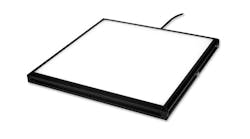MARCH 29--Snecma (Villaroche, France), a Safran Group company that designs, develops, and produces engines for civil and military aircraft, launch vehicles, and satellites, is using a Silver 450M thermal IR camera from Cedip Infrared Systems (Croissy-Beaubourg, France; www.cedip-infrared.com ) to help its engineers improve the design of its aero-engines. The engineers sought to better understand the behavior of differently treated engine turbine blades when subjected to extreme vibration testing.
To simulate vibration conditions researchers mounted a turbine blade on a fixed, rigid support and subjected it to air blasts in excess of what would be encountered in an aero-engine in extreme use. Crack propagation was induced by gradually increased the frequency of the intense air blasts to the resonant frequency of the turbine blade.
Using the Cedip camera, engineers were able to pinpoint the exact stress limit of differently treated turbine blades as the appearance of a crack is preceded by a localized heating effect. During crack propagation, the temperature at this point rises by several hundred degrees. However, as the point is very small and the crack-propagation process only a few milliseconds, this places demands on the IR camera.
Incorporating the latest ROIC technology, the Silver 450M 320 x 240-pixel format InSb detector delivers 400-Hz full frame rate while maintaining linearity and high sensitivity. The camera can synchronize image capture to even the most transient events. Incorporating an integral optical front end, company engineers were able to precisely focus on microscopic areas of turbine blades, and then using the bayonet mounting quickly change the lens to adapt the field of view for turbine blades of different sizes. Transferring images at a full 14-bit dynamic range via a CAMLINK interface to a remote PC enabled engineers to record a complete 15-minute experiment with good thermal discrimination from ambient to 800°C.




